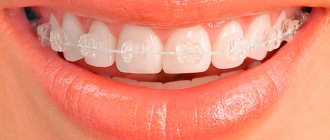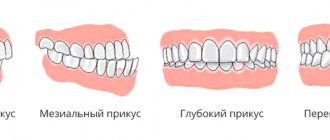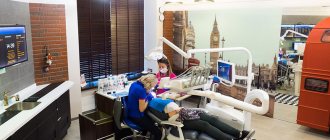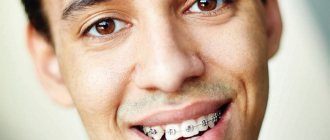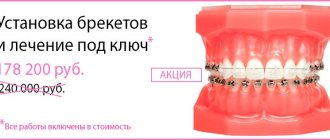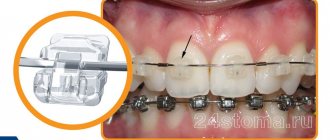Everything you would like to know about correcting your bite and straightening your teeth with braces.
Let's be honest: in modern realities, a beautiful smile is the norm, and it is necessary to get rid of dental imperfections. But, having set such a goal, it is desirable to have reliable information about existing methods and upcoming tests. We tried to collect in one article all the most important things about braces in order to save you from having to look for answers on your own on the Internet, where the truth is mixed with myths and advertising fluff.
Important! In the article, prices are indicated for St. Petersburg and the Leningrad region.
How are braces different from aligners?
This question worries many: is it possible to pay more, but get by wearing transparent removable aligners? The truth is that nice aligners can only cope with minor problems (for example, with one tooth that has grown incorrectly), but only fixed structures - those same “ugly braces” - can create an orthodontic load to shift the dentition.
As for cap-aligners, to achieve the effect, it is recommended to wear them at least 22 hours a day, removing them only during meals. As practice shows, a person often violates such rules by being distracted, forgetting, or simply allowing himself some indulgence. Strictly speaking, aligners are not intended to correct bites, and if they are positioned as such on the clinic’s website, it is better to turn to other specialists.
And the financial point: you will have to pay not more for the aligners, but much more, because during the treatment period they need to be changed at least 15 times (and sometimes much more), so the average minimum cost of correction with the help of aligners should be considered an amount of about 250- 300 thousand rubles.
Which systems are better - with or without a ligature?
There is no clear answer to this question. From an aesthetic point of view, the best ones are those without ligature. For example, the H4 self-adjusting bracket system (OC Orthodontics) is considered one of the most aesthetic, and due to its variability and low profile, also the most effective.
It is important to understand that the main task of any brace system is to straighten the dentition and correct the bite, therefore, to correct uncomplicated anomalies, a system without a ligature is suitable, but to eliminate serious defects you will have to choose a traditional ligature design.
Only a competent orthodontist can choose the ideal braces for a patient, taking into account his individual dental characteristics, age and lifestyle.
Installing and wearing braces: does it hurt?
When installing braces, the vast majority of patients do not experience any noticeable pain, but discomfort certainly appears, and you will have to get used to the braces - for some faster, for others longer, on average - 1-2 days. The exception is, perhaps, people with a very low pain threshold or with increased impressionability - it is from them that the myths about the pain of installing and wearing braces come.
In fact, sometimes there is irritation of the mucous membranes of the lips and cheeks. To solve this problem, a special wax is used, which the doctor will definitely suggest after installation.
Content:
- Who is recommended for teeth straightening with braces?
- Preparing to align rows with braces
- Installation of braces
- Wearing braces during teeth straightening
- Removing the leveling device
- How long to wear braces
- When alignment with braces is not possible
How do braces straighten teeth? They do not do this by themselves, since in reality they play only a secondary role. After all, the term “braces” hides tiny locks that are responsible for holding the metal arch. It is the latter that does all the leveling work - moves the curved units and forces them to take the correct positions. But it just so happened that the entire orthodontic structure was named after the miniature locks.
I’ll take off my braces, a couple of years will pass, and my teeth will return to their place... is this true?
But this is true - but from the practice of past years! Now, after removing braces, the dentition is secured using a special non-removable retainer apparatus; previously this was not always done - hence the accumulated complaints. Today, orthodontists are required to install such a device.
A retainer is a thin wire that is installed on the inside of the front teeth and prevents them from moving apart. And this is for the rest of your life, but you shouldn’t worry: the delay is imperceptible, those around you don’t see it, and if it breaks, it’s easy to fix—just don’t delay your visit to the doctor.
Another problem is more pressing: sometimes, after straightening the dentition, previously hidden aesthetic defects (for example, different lengths of teeth) become noticeable. In this case, you will really have to resort to restoration or buy expensive veneers.
Important! The orthodontist must notice such defects and warn the patient before starting treatment.
Excursion into history
At the beginning of the 20th century, the American doctor Edward Engle created the first prototype of the braces system and called it the Engle apparatus. Angle's apparatus consisted of an elastic stainless steel arc and ligature elements. The arc was tightly fixed in the tubes. The tubes were soldered to orthodontic rings placed on the first molars. Each tooth was tied to an arch curved in the shape of the dentition with a ligature wire.
Subsequently, the scientist significantly changed the original design and developed the edgewise technique. Orthodontic locks, edgewise, were a rectangular piece with a groove. An arc was inserted into the groove and the lock was locked with a pin. Subsequently, the design of braces was modified: orthodontic arches with a square and rectangular cross-section profile, with sharp and rounded edges, appeared.
Later, the edgewise technique was further modified by doctors. Thanks to the active development of orthodontics in the 20th century, the modern operating principle of braces was formed. Today, the doctor is offered various options for torque and angulation. Torque (or inclination) is the deviation of a tooth from its axis in the vestibulo-oral direction. Angulation is the deviation of the tooth in the mesio-distal direction. Taking into account torque and angulation allows, based on a specific clinical case, to individually select the optimal brace option for each tooth.
Do braces damage enamel and lead to caries?
No, the tight fit of the braces completely eliminates the penetration of food debris and microbes into the tooth; Dental enamel glue used in practice is harmless, moreover, it contains the useful element fluorine. The brace-lock even protects the tooth in a certain way.
But improper care of braces is really fraught with trouble: oral hygiene after installation of an orthopedic structure requires more attention and responsibility due to the increased accumulation of plaque. And where there is plaque, there is caries!
Preparing to align rows with braces
Before installing braces, the doctor makes sure that the gums and teeth are in satisfactory condition.
If there is caries, pulpitis, gingivitis or any other dental disease, it must be treated. After installing metal arches, it is much more difficult to combat the symptoms of oral diseases. Also during the preparatory stage:
- radiography;
- taking impressions of both jaws;
- articulator examination.
Considering that each clinical case is unique, the patient may be prescribed consultations with a surgeon, orthopedist, or implantologist.
Is it necessary to use additional products to clean braces?
On forums (and sometimes in the recommendations of “experts”!) there are numerous additional products that supposedly make oral hygiene easier in the presence of braces (rinses, ultrasonic brushes, etc.)
In fact, with a responsible approach, it is quite possible to get by with three basic tools (toothbrush, dental floss, brush). In this case, you should not rely on someone else’s opinion. The quality of care will be assessed by a doctor who conducts regular examinations, and he will also recommend additional remedies, if necessary.
A little anatomy: how teeth move in wire braces
The design specifics do little to explain the principle of operation of the bracket. How to move a rigid molar when it is securely fixed in the jaw?
The explanation for this process is quite simple. The secret of braces is hidden in the biomechanical features of tooth displacement.
Milk and permanent teeth are located in the alveolar sockets. These are depressions in the jaws, and the roots of the teeth are hidden in them. Each root is surrounded by periodontal fibers, which are responsible for the strong fixation of the tooth. The periodontium also performs a shock-absorbing function, which allows the teeth to move in any direction – over microscopic distances.
As soon as the doctor installs braces and secures the arch, the tooth root immediately takes the load and begins to move in the given direction. It would seem that such processes should provoke loosening and loss of teeth, but this does not happen, since the following come into play:
- Osteoclasts - remove bone by dissolving collagen and mineral components at the point of contact between the root and the socket wall.
- Osteoblasts - synthesize new bone tissue to fill the vacated space.
Thus, osteoclasts and osteoblasts maintain balance in the processes of formation and destruction of the jawbone and guarantee smooth movement of teeth during bite correction. Bone remodeling occurs and the tooth maintains a rigid and strong position in the jaw, while changing the abnormal position to the correct place in the bite.
The processes do not occur quickly - the tooth moves 1 mm in 30 days. This explains the duration of the bite correction process.
Rodikova Tatyana
Similarly to braces, aligners also correct teeth. They also gently and accurately move teeth in the desired direction. At Azabuka we work with both systems. The choice is made by children, assessing the attractiveness and features of each design.
Is there a need to give up your usual food?
As a rule, when installing a brace system, the doctor will actually announce “forbidden” foods, and this list looks quite depressing (cookies, chips, seeds/nuts, crackers, chewing gum, pizza, chocolate bars, etc. - everything that can stick to the structure , creating conditions for the proliferation of microbes, or damaging it). But in this case, the doctor’s recommendations should be approached in a differentiated manner: there is a clear reinsurance here, the only thing that is actually required from the patient is caution.
Who can benefit from braces?
Orthodontists are confident that now there are practically no anomalies in the position of teeth that could not be corrected with a braces system. Teeth are mobile, and even over the course of a person’s life, their position may change slightly. The main diagnoses that are made at the consultation stage are the following:
• Crowding of teeth. This looks like the teeth are incorrectly positioned, they are turned at the wrong angle, they are in front or behind the dentition. Too large gaps between the teeth (most often between the front teeth in the upper jaw). • Incorrect bite. The lower jaw is located too far inward or forward in relation to the upper. • The upper or lower jaw is too small. • Other pathologies.
It happens that these problems arise due to genetic predisposition. At some point, the incorrect position of future teeth was formed. The milk teeth fell out too early or too late, or some milk tooth did not fall out at all, since there were no rudiments of the main tooth under it, and the like. Sometimes anomalies turn out to be acquired: if several teeth were lost and implantation was not carried out on time, the teeth, as they say, “went” to occupy convenient places.
Is it true that sapphire braces are the best?
Sapphire braces are much more expensive than iron braces, but their advantages do not lie in the effectiveness of treatment. Moreover, in reliability they are inferior to metal ones. But on the teeth, such brace systems look much more aesthetically pleasing, since transparent brace locks are almost invisible.
Let us clarify: the precious natural stone sapphire has nothing to do with the production of such briquettes; we are talking about artificially grown crystals.
By the way, there are also cheaper transparent braces - ceramic (much more expensive than metal ones, but not as expensive as sapphires) and plastic designs. Only the former are too fragile and unstable in relation to food dyes (can lead to yellowing of teeth), and the latter are intended only for short-term use.
The principle of operation of the braces system
So, how do dental braces work? The main corrective link is the orthodontic arch. After X-ray diagnostics and determination of the ideal bite for a particular patient, the doctor makes calculations and selects an arch of the desired shape and cross-section.
During the correction process, the orthodontic arch tends to the shape specified by the orthodontist and pulls the parts fixed on it - locks, springs. And since the bracket is attached to each tooth, the teeth also move.
To maintain the strength and functionality of the structure, the doctor periodically replaces the weakened arch with a new one. In the first stages, the thinnest wire is used, gradually increasing the thickness.
How much do simple metal braces cost?
The remarkable cheapness of hardware is just a myth supported by some clinics. Indeed, by indicating the cost of one element of the braces system, they create the illusion of affordable treatment, but the patient should understand that the treatment process involves paying for braces, dental materials, multiple visits to the doctor and various procedures, including removal of the system at the end of treatment - and all this will cost at a very decent amount.
On average, the price of a course of treatment in an ordinary case (healthy teeth, simple defect) is 150-170 thousand rubles. (and this does not take into account preliminary professional teeth cleaning and diagnostics). If you have tooth decay and/or gum problems, you should add the cost of treatment or surgery to this amount. After removing the braces, you will have to pay for the installation of retainers, and, if necessary, restoration or installation of veneers.
Important! There is no point in finding out the cost of braces over the phone, since each case is individual; choose the clinic where they will tell you the amount of all necessary procedures and operations - so to speak, the amount of “turnkey” treatment.
Stages of treatment
The first stage is preparation for orthodontic treatment. Preparation includes x-ray diagnostics, sanitation of the oral cavity and removal of the required number of teeth.
The second stage involves fixing the structure. An initial thin arch with a round cross-section profile is installed. Further in the treatment process, the doctor changes the arcs from a smaller cross-sectional diameter to a larger one. At the final stages, rectangular rigid arches are used.
On average, it is necessary to visit a doctor from once a month when treating with ligature models to once every 2-2.5 months when treating with self-ligating systems. At the end of the second stage of treatment, the doctor removes the braces using enamel-safe forceps. The remaining adhesive is removed from the surface of the teeth with a low-abrasive bur, and the tooth is polished with a brush using a polishing paste.
The third stage is the retention period. The results of orthodontic treatment are stabilized with the help of permanent retainers and aligners.
The duration of treatment depends on the complexity of the anomaly being corrected, the individual anatomical characteristics of the patient and the professionalism of the orthodontist. The speed of tooth movement is influenced by the design of the brace: self-ligating systems can provide faster results in 1-2 years. Treatment with ligature models lasts on average 2 to 3 years.
Some dental anomalies are corrected using removable hard aligners. When treated with aligners, the patient is given a set of several rigid aligners that differ in shape. The patient changes the aligners independently every two weeks. Once every month and a half, the patient visits the orthodontist to assess the progress of treatment. Mouthguards are worn constantly: the device is removed only when eating and brushing teeth.
What are the advantages of ligature-free braces? And do they exist?
Ligatures are wires or elastic rings with the help of which bracket locks are attached to the arch. In ligature-free bracket systems, the arch is inserted into a special clip, and ligatures are not needed.
Self-ligating braces (also known as self-ligating braces) have been aggressively promoted for some time, causing their prices to rise. However, time and practice have shown that the advantages attributed to such systems are absent (including the myth about the special strength achieved due to minimal friction of the archwire with the bracket locks).
Types of bracket systems
Orthodontic technologies are improving every day. In addition to ligature and self-ligating systems, the following designs are distinguished:
- Vestibular – attached to the visible part of the tooth crown.
- Lingual “invisible” ones are located on the inner side of the teeth, facing the tongue.
Division by materials:
- Metal braces are inexpensive and most effective. The period for correcting a bite with metal braces is the shortest.
- Ceramic braces are white and hardly noticeable on the teeth. They are often used in combined designs, when ceramics are placed in the frontal zone, and inexpensive and unesthetic metal is placed on the chewing teeth.
- Sapphire – braces made from medical sapphire are aesthetically pleasing and are great for picky teenagers. To decorate transparent shiny systems, children often choose colored rubber bands-ligatures, forming their own image in the social environment.
Alina Soldatenkova
You must understand that metal always means strong and stable pressure. There is no fragility in it, like in ceramics or sapphire braces, which is why correction with metal braces is faster.
Are lingual braces worth their high cost?
The most expensive lingual brace systems today are much more expensive than expensive sapphire braces; correction costs the patient up to 500 thousand rubles. But progressive doctors have already abandoned this solution, the only advantage of which is invisibility to others due to installation on the inside of the teeth.
This only advantage is greatly diluted by numerous disadvantages: adaptation to such systems is more difficult and longer (up to several months), the likelihood of injury to the tongue is high, the effect on diction is more pronounced, the requirements for caring for them are stricter, and recovery in case of peeling is more difficult.
Is there an alternative to braces?
According to most experts, braces are the most effective device for eliminating dental anomalies. But minor violations can be corrected using other devices:
- plates - can be either removable or non-removable; are an alternative to braces for children; used mainly for bite correction; They are rarely installed in adults and only for minor pathologies;
- mouth guards for teeth straightening (aligners) – can be used not only after braces, but also independently; this is a good alternative to braces, but only for minor dentition problems; They are installed mainly in adults due to the high price.
Retainers cannot be an alternative to braces, as they fix teeth in one position, preventing them from moving. The most reliable and effective device for correcting dental anomalies is a brace system installed by an experienced orthodontist.
Is it possible to put braces on only one jaw?
Many patients are perplexed: why, if, for example, 1-2 upper teeth are displaced, why install a system on the entire jaw. The desire to minimize inconvenience and costs is quite understandable, but the realities are different: teeth are straightened not by braces, but by the device that is attached to them, and the force of its influence must be uniform, which requires fixation on the entire dentition. Otherwise, the “crooked” tooth will fall into place, but will inevitably push others out of the row.
The concept of a “partial bracket system,” however, exists - such systems are installed on one jaw and cost half as much. However, such a correction is possible only in the absence of bite pathologies and strict symmetry of the teeth of the upper and lower jaws, when there is only a slight curvature of 1-2 teeth (according to statistics, in orthopedic practice there are no more than 5% of such cases).
When alignment with braces is not possible
You cannot straighten your teeth using braces if:
- Full or partial edentia. There will simply be nothing to consolidate the basics on.
- Acute mental disorders. A mentally ill person may want to remove the device themselves and cause harm to themselves.
- Diabetes mellitus, severe diseases of the immune and endocrine systems. With these pathologies, the condition of blood vessels and bone tissue worsens. If the tissue becomes inflamed after braces are installed, the tooth may become loose and fall out.
It is also not recommended to install braces if you have bleeding disorders, HIV infection, sexually transmitted diseases, tuberculosis, or oncology. Treatment of malocclusions using braces requires a responsible and competent approach. Therefore, it is very important to entrust the therapy to an experienced and highly qualified doctor.
Is it possible to install and wear braces during pregnancy?
Pregnancy is a period of serious changes in a woman’s body, including, among other things, bone tissue, tooth roots and bone plates. This is definitely a stressful condition, which should not be aggravated.
Thus, it is strictly forbidden to begin correcting the bite if there are plans to expand the family or in the process of bearing a child, and if an unplanned pregnancy occurs during the current course of correction, the brace system must be removed as quickly as possible.
Vestibular and lingual – which is better?
First, let's compare braces according to where they are attached to the teeth. Each orthodontic design has its own indications, advantages and disadvantages. And despite the fact that any braces are created to solve the main problem - correcting the bite, it is worth carefully considering the options in order to choose the best one.
Vestibular braces - a familiar classic
Vestibular braces are fixed on the front surface of the teeth and are considered the most popular in modern orthodontics. Such designs do not lead to impaired diction and are easy to maintain. The duration of therapy using the vestibular system depends on the severity of the defects. Since the external brace system is very noticeable on the teeth, the choice of materials for its manufacture must be approached very responsibly:
- metal is a reliable and at the same time very noticeable material on the teeth; many patients note its unaesthetic appearance;
- plastic is a more fragile but aesthetic material, the color of which can be selected in accordance with the natural color of the enamel, has a low cost and is often used in the manufacture of budget braces for the correction of minor defects in children and adults;
- ceramics are a more expensive alternative to plastic; ceramic structures are aesthetically pleasing and hypoallergenic;
- sapphire is the most durable, aesthetic and expensive material; sapphire braces are transparent and almost invisible on the teeth.
Some patients say the main disadvantage of vestibular braces is the inability to completely close the mouth after installation. It is worth noting that such an effect is indeed possible in case of serious bite pathologies or if the system itself is selected incorrectly.
Lingual braces are the second most popular
At one time, lingual braces replaced vestibular braces; they are fixed on the inner surface of the teeth; for their installation, a special base is made that replicates the anatomical structure of the patient’s teeth. Lingual systems are more expensive than classic ones and more difficult to manufacture, but it was their appearance that eliminated the main problem of conventional vestibular systems, because unlike them, lingual braces became almost invisible.
In recent years, some types of braces, including lingual ones, have seriously improved - they have become thinner
,
light
and hypoallergenic.
3 main advantages of lingual systems:
- They are not noticeable. And this is really a big plus of lingual structures, because in order to notice them, a person must either look closely at your jaw, or simply know that the braces are installed from the inside and specifically pay attention to this.
- When creating lingual braces, 3D modeling technology is used. This means that the predicted result of therapy can be seen even before it begins.
- Throughout the entire treatment period, the orthodontist, together with the patient, can make adjustments to the design. Classic braces do not offer this possibility.
5 main disadvantages of lingual braces:
- Therapy with lingual braces is quite painful, even compared to classic ones.
- When correcting an overbite with lingual braces, diction is seriously affected. Since the system is fixed from the inside, from the side of the tongue, it becomes very difficult to pronounce familiar words. The so-called logoneurosis may even develop, when the patient loses patience and becomes very nervous due to the fact that the usual sound pronunciation becomes inaccessible to him.
- Parts of lingual braces can injure the tongue, especially at the initial stage of treatment.
- Therapy using internal braces lasts longer than with vestibular braces.
- There are restrictions for adult patients in certain types of intimacy. As we mentioned above, lingual braces can injure the patient’s tongue, but this warning also applies to his sexual partner - any sensitive mucous membrane is at risk. Doctors do not always warn about this disadvantage of lingual braces, but this does not eliminate the problem itself.
As you can see, despite a number of advantages and high cost, lingual braces are not indicated for all patients and have a number of features. Wear invisible braces, but put up with the inconvenience or choose a vestibular system - it’s up to you.
At what age is it better to start correcting a child’s bite?
The optimal age to begin orthodontic treatment is after the formation of the bite is completed (usually at 11-12 years). Why shouldn’t you follow the recommendations of some clinics that invite patients aged 7-9 years for treatment?
The answer is provided by the results of a scientific study of tooth growth and bite formation in children, which showed that the curvature of the dentition during the period of replacement of milk teeth with permanent teeth is not indicative and does not require intervention, since the dentition gradually straightens naturally (for example, the lateral teeth eliminate the gap between In front of them).
This, of course, does not mean that you should not visit a pediatric orthodontist if you see reasons for concern. The primary bite is formed by the age of 3-4 years, and from this age you can consult with specialists. But you shouldn’t start treatment unless there are good reasons for it.
Finally, a general recommendation: the patient does not have to agree with the doctor’s opinion in everything if it seems erroneous. Consult another clinic, get an alternative opinion, because we are talking about your health, about your appearance, about your money, finally. Get treatment from those you trust!
Caring for braces after installation
After installing braces, the patient's body must get used to them. At first, they can rub the inner surface of the lips or tongue, causing pain, problems with taste and diction. But if you follow all the doctor’s recommendations, within 1 – 2 weeks after installing braces, your teeth will not hurt, all discomfort and speech disorders will disappear. The patient will simply stop perceiving braces as something foreign. If braces irritate the inner surface of the cheeks or lips, erosions and ulcers form on the mucous membrane, then, as prescribed by the doctor, the clasps are covered with special wax or silicone. A piece of wax is lightly kneaded in your hands and pressed into the lock, after cleaning and drying your teeth and braces.
Diet restrictions
For the first few weeks after installation of braces, it is recommended to eat only liquid and mushy foods. Gradually, dishes can be diversified. But it is better to grind solid foods first in a blender. It is also better not to consume very cold or very hot food and drinks. The following products will need to be completely eliminated while wearing braces:
- anything that sticks to the teeth - chewing candies (taffy, soft caramel), Turkish delight, nougat, chewing gum;
- everything that stains teeth - beets, red wine, strong black tea, coffee, Coca-Cola.
Limit: sweets and baked goods, as they are an excellent breeding ground for microorganisms present in the mouth.
How to brush teeth with braces
When starting to brush teeth with braces with a regular brush, the patient notices that it is impossible to do this efficiently. Therefore the following are produced:
- special toothbrushes with V-shaped bristles:
- cone-shaped (mono-beam) toothbrushes:
- interdental brushes:
- dental floss (floss); They come in different types depending on how closely the teeth are arranged in the dentition.
Such devices perfectly clean both teeth and braces. You should consult your dentist about which toothpaste is best to use. He will recommend the most suitable toothpaste for the patient.
You can also use irrigators to clean hard-to-reach places with a water jet. These devices do not injure the gums at all:
But even this will not be enough. If you have had braces installed, you should visit a dental hygienist at least twice a year for professional teeth cleaning.
Orthodontist visit schedule
The frequency of consultations depends on the type of braces installed. Classic ligature braces require a visit to the orthodontist to correct the tension of the arch once every 1.5 - 2 months. If ligature-free active braces are installed, the doctor may schedule less frequent visits. The easiest way to treat is with passive non-ligated Damon System braces. These are self-regulating systems, so recovery of disorders occurs faster and does not require frequent visits to the orthodontist.
If braces cause severe, increasing discomfort, you should immediately contact an orthodontist.
How to care for your oral cavity?
If you do not take good care of your mouth while wearing braces, your gums may become inflamed. After installation of the structures, it becomes more difficult to brush your teeth, so the duration of this procedure should not be less than ten minutes. At the same time, this must be done after every meal without toothpaste (otherwise it will negatively affect the enamel). If you cannot use a toothbrush, you need to rinse your mouth. This will remove food debris from the system.
It is worth noting that you need to use a special paste and brush. As already mentioned, a simple remedy cannot be used. If you follow this recommendation, you can maintain your dental health. Ideally, you should also visit a specialist at our orthodontics clinic to have professional cleaning done:
- process enamel;
- remove tartar;
- seal fissures.
So, treatment with braces is not only wearing these structures, but also careful oral care.
Pulling a tooth from the gum using systems
Pulling a tooth out of the gum is a complex process that is accompanied by a lot of time.
The type of corrective systems is chosen by the patient, but presentable models made of ceramics and sapphire are in particular demand. People also prefer translucent locks. After choosing braces, the patient is prescribed surgical intervention with a tomographic examination and determination of the location of the pathological tooth, to which a small lock resembling a button with a chain is attached. The operation is not accompanied by pain, but during the first 10 days you need to monitor the condition of the wound and treat it. The pulling process also does not cause discomfort, but its duration reaches several months or years, depending on the complexity of the case. The doctor's consultation
Do braces make it difficult to eat?
Once installed, you will need to learn how to eat in them. This period takes on average 3-7 days.
At this time, give preference to soft and liquid foods. Cut fruits and vegetables into small pieces. Avoid fibrous and sticky foods.
Over time, you will be able to eat almost everything except Coca-Cola (can dissolve glue), hard foods (nuts, crackers, chocolate) and sticky sweets (chocolate, cookies or caramel bars). You should also not chew gum.
Which ceramic braces are better?
Several models from different companies are used in this work. All have different characteristics.
Brand "Damon"
The manufacturer produces non-ligature types based on a clip, which is an advantage. The design does not oxidize and does not change color. Braces reduce wearing time.
Brand "Clarity"
It does not shimmer or shine in the sun, so the system is invisible in the oral cavity. The color does not stand out from the natural shade of the enamel, making the product less noticeable. Ceramics do not irritate the mucous membrane. It is also hypoallergenic. Small locks are not felt.
Can adults get braces to correct their bite?
Anyone can correct a malocclusion, regardless of age. But in an adult, this process takes longer than in children, because skeletal growth has already stopped and hard bones are more difficult to form.
In addition, some oral health conditions may delay the installation of braces. For example, caries, periodontal disease, endocrine diseases.
Sometimes the effect of treatment is influenced by the presence of crowns and bridges. The treatment period starts from 1.5 years.
